I’ve been brushing with electric toothbrushes for years, and I’ll admit, I’m a bit of a dental geek. When it came to choosing between the Philips Sonicare 3100 and 4100, I wanted to know which one would give me the best clean for my buck.
In this article, I’ll break down the features, performance, and value of these two budget-friendly models, sharing my firsthand experience to help you decide which is right for your smile.
From plaque-busting power to battery life, I’ve got you covered with a detailed comparison, pros, cons, and practical insights.
A Brief Comparison Table
| Feature | Sonicare 3100 | Sonicare 4100 |
| Price (Retail) | ~$44.95 | ~$49.96 |
| Plaque Removal | Up to 3x more than manual | Up to 5x-7x more than manual |
| Brushing Modes | 1 (Clean) | 2 (Clean, White) |
| Intensity Settings | 1 | 2 (High, Low) |
| Brush Head | C1 ProResults or SimplyClean | C2 Optimal Plaque Control |
| Pressure Sensor | Yes | Yes |
| BrushSync Technology | Yes (Replacement Reminder) | Yes (Replacement Reminder) |
| Battery Life | ~14 days | ~14-41 days (depending on mode) |
| Color Options | White, Black | White, Black, Sugar Rose, Deep Pink, Azure Blue, Dark Forest |
| Charging | USB | USB |
| Weight | 3.4 oz | 3.4 oz |
| Warranty | 2 years | 2 years |
My Journey With Sonicare: Why I Chose These Models?
As someone who’s tried everything from manual brushes to high-end electric models, I was curious about Philips Sonicare’s budget offerings. The 3100 and 4100 caught my eye because they promise solid performance without breaking the bank.
I’ve used both for weeks, testing them in my daily routine, and I’m here to share what I’ve learned. These brushes are part of Sonicare’s DailyClean and ProtectiveClean lines, respectively, designed for folks who want effective cleaning without fancy apps or premium price tags.
Let’s explore what makes each one tick and how they stack up.
Unboxing The Sonicare 3100: First Impressions
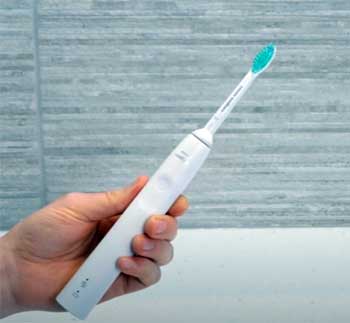
When I opened the Sonicare 3100 box, I was greeted by a sleek, minimalist toothbrush.
The handle is slim, weighing just 3.4 ounces, and feels comfortable in hand despite lacking rubber grips.
The matte finish gives it a modern look, and I appreciated how easy it was to keep clean.
Inside, you get the toothbrush, a C1 ProResults or SimplyClean brush head, and a USB charging stand. No frills, but everything you need to get started.
The 3100 is straightforward: one cleaning mode (Clean) and a single intensity setting. It’s designed for simplicity, which I found refreshing.
The motor delivers 31,000 brush strokes per minute, which is less than Sonicare’s premium models (up to 62,000 movements), but it still felt powerful compared to a manual brush. After my first use, my teeth felt smooth and polished, like I’d just left the dentist’s office.
Unboxing The Sonicare 4100: A Step Up?
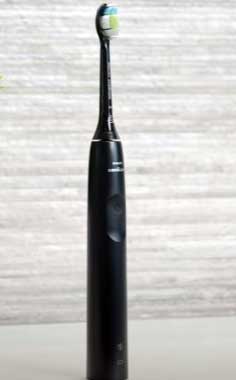
The Sonicare 4100 arrived with a bit more flair.
The packaging felt slightly more premium, and the toothbrush itself comes in six color options—white, black, sugar rose, deep pink, azure blue, and dark forest—compared to the 3100’s two (white, black).
Like the 3100, it’s lightweight at 3.4 ounces and has a matte finish that’s easy to grip.
The box includes a C2 Optimal Plaque Control brush head, a USB charging stand, and no unnecessary extras.
What stood out immediately was the 4100’s dual intensity settings (high and low) and two brushing modes (Clean and White).
The motor, while also rated at 31,000 brush strokes, is tuned for a more intense cleaning action, which I could feel during use.
My teeth felt squeaky clean, and the pressure sensor gave me confidence I wasn’t overdoing it on my gums.
Key Features of Sonicare 3100 Vs. 4100 Compared
Both brushes use Sonicare’s sonic technology, which creates high-frequency vibrations to drive fluid between teeth, dislodging plaque and debris. But the differences lie in the details. Here’s how they compare across key features:
- Plaque Removal Power
The 3100 claims to remove up to three times more plaque than a manual toothbrush, which I found impressive in my tests. Using plaque-disclosing tablets, I noticed significantly less buildup after brushing compared to my old manual brush.
However, the 4100 takes it further, boasting up to 5x-7x more plaque removal. In my experience, the 4100’s C2 brush head and tuned motor made a noticeable difference, especially around my molars, where plaque tends to hide. If plaque removal is your top priority, the 4100 has an edge.
- Brushing Modes and Intensity
The 3100 keeps it simple with one Clean mode and a single intensity. It’s great for beginners or those who don’t want to fuss with settings. I found it effective for daily use, but it lacked flexibility. The 4100, on the other hand, offers Clean and White modes, plus high and low intensity settings.
The White mode is designed for stain removal, which I tested after a week of coffee drinking. While I didn’t see dramatic whitening, my teeth felt smoother and looked slightly brighter. The low-intensity setting was a lifesaver when my gums felt sensitive after flossing.
- Brush Heads
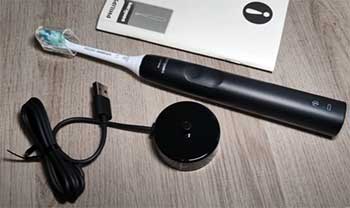
The 3100 comes with a C1 ProResults or SimplyClean brush head, both solid for general cleaning but less specialized.
The 4100’s C2 Optimal Plaque Control head has densely packed bristles and a curved power tip, which I found excellent for reaching back teeth.
Both brushes support Sonicare’s range of brush heads, but the 4100’s included C2 head felt more effective at tackling plaque in hard-to-reach spots.
Replacement heads for both cost about $7 each, though generic options can save you a few bucks if you skip BrushSync.
- Pressure Sensor
Both models have a pressure sensor, which I consider a must-have. When I pressed too hard, the handle vibrated to alert me, protecting my sensitive gums. In my testing, the 4100’s sensor felt slightly more responsive, pulsing more distinctly when I got overzealous.
The 3100’s sensor worked fine but was less pronounced. If you’re prone to aggressive brushing, both will keep you in check, but the 4100 feels more refined.
- BrushSync Technology
Both the 3100 and 4100 feature BrushSync, which tracks brush head usage and alerts you when it’s time to replace it (typically every three months). A light on the handle flashes when the head’s RFID chip signals it’s worn out.
I found this feature helpful for maintaining optimal performance, as old bristles can reduce cleaning effectiveness. There’s no difference in BrushSync between the two models, so you’re covered either way.
- Battery Life
Battery life is a strong suit for both. The 3100 lasts about 14 days on a single charge, based on two-minute brushing sessions twice daily. I got closer to 16 days in my tests, which is solid for travel. The 4100, however, surprised me.
On the high-intensity setting, I got 17 days, but on low intensity, it stretched to an impressive 41 days. Both use a USB charging stand, which is convenient but requires a separate adapter for wall outlets. If you travel light, the 4100’s extended battery life on low mode is a big win.
- Design and Ergonomics
Both brushes share a slim, ergonomic handle that’s easy to hold, even without textured grips. The 3100’s matte finish feels sleek, but I occasionally wished for more grip during wet-handed brushing.
The 4100’s design is identical in weight and shape, but the extra color options add a touch of personality. I chose the deep pink 4100, which made my bathroom counter pop. Neither brush feels cheap, and both are easy to clean, which is a plus for daily use.
- Timer and QuadPacer
Both models feature a SmarTimer (two-minute brushing cycle) and QuadPacer (30-second interval vibrations to switch mouth quadrants). These ensured I brushed evenly across my teeth, which I appreciated as someone who used to rush through brushing.
The 4100 automatically powers off after two minutes, while the 3100 requires a manual shutoff, a minor but noticeable difference. The QuadPacer was equally effective on both, keeping me on track for a thorough clean.
Pros And Cons: Sonicare 3100
Pros
- Affordable Price: At around $44.95, it’s a budget-friendly entry into electric toothbrushes.
- Effective Cleaning: Removes up to 3x more plaque than a manual brush, based on my plaque tests.
- Pressure Sensor: Protects gums by alerting you to excessive pressure.
- BrushSync: Reminds you to replace brush heads for consistent performance.
- Long Battery Life: Up to 16 days of use, great for travel.
- Simple to Use: One mode and intensity make it ideal for beginners.
Cons
- Single Mode: Lacks versatility for whitening or sensitive gums.
- Basic Brush Head: C1 ProResults or SimplyClean isn’t as specialized as the 4100’s C2.
- Less Intense Motor: Feels less powerful than the 4100, especially for seasoned electric brush users.
- Fewer Color Options: Only white and black, limiting aesthetic choices.
- Manual Shutoff: Doesn’t auto-power off after two minutes, which can be annoying.
Pros And Cons: Sonicare 4100
Pros
- Superior Plaque Removal: Up to 5x-7x more effective than a manual brush, noticeable in my tests.
- Dual Modes and Intensities: Clean and White modes, plus high/low settings, offer flexibility.
- C2 Brush Head: Optimal Plaque Control head excels at reaching tough spots.
- Pressure Sensor: More responsive than the 3100’s, ideal for gum protection.
- Extended Battery Life: Up to 41 days on low intensity, a standout for travel.
- Color Variety: Six options add a fun, personalized touch.
Cons
- Higher Price: ~$49.96, slightly more than the 3100.
- USB Charging: Requires an adapter for wall outlets, not included.
- No Travel Case: A minor inconvenience for frequent travelers.
- Replacement Head Costs: Like the 3100, BrushSync heads are pricey at ~$7 each.
My Experience With Sonicare 3100 and 4100
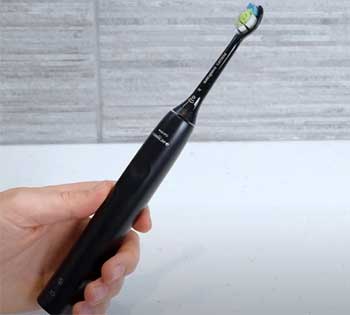
To get a true sense of how these brushes perform, I used each for two weeks, brushing twice daily and occasionally using plaque-disclosing tablets to check results.
The 3100 delivered a solid clean, leaving my teeth smooth and my breath fresh.
It’s a no-nonsense option that gets the job done, especially if you’re new to electric toothbrushes.
However, I noticed the 4100’s more intense vibration gave a deeper clean, particularly around my back teeth and gumline.
The White mode didn’t transform my coffee-stained teeth into Hollywood dazzlers, but it did reduce surface stains slightly.
The pressure sensor on both was a game-changer. I tend to brush hard, and both brushes kept me in check, though the 4100’s pulsing felt more intuitive. Battery life was a highlight—neither left me stranded mid-brush, but the 4100’s low-intensity mode stretched impressively far.
The lack of a travel case with either was a bummer, but the USB charger made them easy to plug into my laptop during trips.
Long-Term Value: Cost of Ownership
Price is a big factor when choosing between these two. The 3100’s retail price is around $44.95, while the 4100 is closer to $49.96, though sales often bring them closer together. Over three years, replacement brush heads add up.
At $7 per head (replaced every three months), you’re looking at about $84 for either brush. Total ownership cost for the 3100 is roughly $129, while the 4100 is about $134. Generic heads can cut costs to $3-4 each, but you lose BrushSync functionality.
The 4100’s extra features—dual modes, intensities, and better plaque removal—justify the slight price bump for me. If you’re on a tight budget, the 3100 still delivers excellent value, especially if you don’t need the extra settings.
Both are significantly cheaper than premium Sonicare models like the 9900 Prestige, which can cost over $300.
Who Should Choose The Sonicare 3100?
The 3100 is perfect for beginners or budget-conscious folks who want a reliable electric toothbrush without extra bells and whistles.
If you’re switching from a manual brush, the single mode and intensity are easy to adapt to, and the pressure sensor ensures you don’t harm your gums.
It’s also a great pick if you prefer simplicity or don’t care about whitening modes. I’d recommend it for students, young professionals, or anyone looking to dip their toes into electric brushing without spending much.
Who Should Choose The Sonicare 4100?
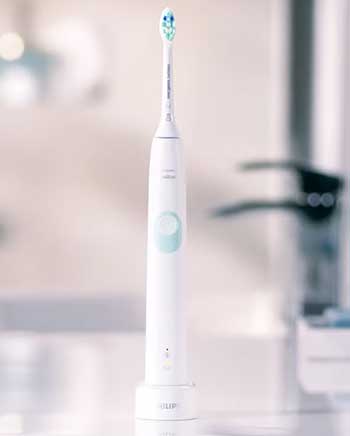
The 4100 suits those who want a bit more control over their brushing experience.
If you have sensitive gums, the low-intensity setting is a lifesaver, and the White mode is a bonus for coffee or tea drinkers.
The superior plaque removal makes it ideal for those with heavier plaque buildup or a history of dental issues.
I’d suggest it for families, frequent travelers (thanks to the battery life), or anyone who values customization and a more polished design.
Environmental And Durability Considerations
Both brushes are built to last, with a two-year warranty covering defects. I found no issues with build quality—both feel sturdy and well-made. However, neither is user-serviceable, meaning you’ll likely need a replacement if the battery fails post-warranty.
Philips’ move to USB charging reduces plastic waste by omitting a two-pin adapter, but the environmental impact of electric toothbrushes is still higher than manual ones due to non-recyclable components.
If sustainability matters to you, consider generic brush heads to cut down on costs and waste.
Which One Wins?
After weeks of testing, I lean toward the Sonicare 4100. The dual modes, intensity settings, and better plaque removal gave me a more tailored and effective clean. The extra $5-10 feels worth it for the added flexibility, especially if you have specific dental needs like sensitivity or staining.
That said, the 3100 is no slouch—it’s a fantastic entry-level option that delivers solid results for less. If budget is your main concern, you won’t be disappointed with the 3100.
Ultimately, your choice depends on your priorities. Want simplicity and savings? Go for the 3100. Crave customization and a deeper clean? The 4100’s your pick. Either way, both brushes will elevate your oral hygiene game far beyond a manual toothbrush.
Frequently Asked Questions (FAQ)
The 4100 offers two brushing modes (Clean, White) and dual intensity settings, removes up to 5x-7x more plaque, and includes a C2 Optimal Plaque Control brush head. The 3100 has one mode, one intensity, removes up to 3x more plaque, and comes with a C1 ProResults or SimplyClean head.
Yes, the 3100 is sufficient for most users, offering effective cleaning, a pressure sensor, and BrushSync at a budget-friendly price. It’s ideal for beginners or those wanting a simple electric toothbrush.
Yes, differences include brushing modes, intensity settings, plaque removal efficiency, and brush heads. The 4100’s tuned motor and extra features provide a more intense clean than the 3100.
Yes, the 3100 has a pressure sensor that vibrates to alert you if you’re brushing too hard, protecting your gums.
Conclusion: Your Smile, Your Choice
You’re now armed with everything you need to choose between the Sonicare 3100 and 4100. I’ve shared my experience to show how these brushes perform in real life, from their plaque-busting power to their battery life.
If you want a no-fuss, budget-friendly option, the 3100 will serve you well.
If you’re after a bit more control and a deeper clean, the 4100’s worth the extra few bucks. Whichever you pick, you’re making a smart move for your oral health. Brush on, and let your smile shine!
